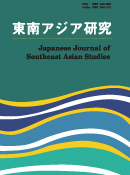All issues

Volume 44, Issue 1
Displaying 1-6 of 6 articles from this issue
- |<
- <
- 1
- >
- >|
Articles
-
Masataka Kimura2006Volume 44Issue 1 Pages 3-30
Published: June 30, 2006
Released on J-STAGE: October 31, 2017
JOURNAL FREE ACCESSOn June 9, 2002, Jeremias U. Montemayor, the founder and supreme leader of the Federation of Free Farmers (FFF) for half a century, passed away. The FFF was formed in 1953 when the communist-led peasant movement was defeated; it became the most dominant peasant organization in the 1960s; and it had remained one of the most influential until his death.
This article focuses on the FFF which can be considered to have been the most significant moderate organization of the Philippine peasant movement that emerged after the 1950s. It analyses the FFF's characteristics in terms of the specialized patron-client model instead of the class model which has usually been employed in studying peasant organizations. Based on the analysis, the paper also discusses the historical significance of the FFF and tries to present a new perspective of the history of the Philippine peasant movement from the 1950s to the 1990s.View full abstractDownload PDF (594K) -
The Case of the Great Depression in SingaporeKah Seng Loh2006Volume 44Issue 1 Pages 31-54
Published: June 30, 2006
Released on J-STAGE: October 31, 2017
JOURNAL FREE ACCESSThis paper discusses the roles of written and oral records in the writing of the social history of Singapore. It takes the case of the early 1930s Great Depression, which has hitherto been treated as a subject of economic history, written from the colonial records.This paper examines how using in conjunction colonial, newspaper, coroner, biographical, and oral records provides a window into the social history of the slump, enabling fresh perspectives into how people were affected by the crisis and how they sought to negotiate it. While a global economic slump might be thought to have severe effects on the residents of a colonial city reliant on entrepot trade, evidence drawn from the wider range of sources suggests that the slump's impact was not uniformly harsh and that people in Singapore were not hapless victims. Many of them actively negotiated the Depression's worst effects, utilising family and kinship ties which had developed among the island's migrant communities.View full abstractDownload PDF (638K) -
The Case of Gotong Royong in Java under the Japanese OccupationKazuo Kobayashi2006Volume 44Issue 1 Pages 55-77
Published: June 30, 2006
Released on J-STAGE: October 31, 2017
JOURNAL FREE ACCESSIn 1942, the Japanese military administration in Java established “The Committee for the Study of Former Customs and Political Systems” (Kyukan Seido Chosa Iinkai) as a consultative body of the administration. Through the participation of Indonesian nationalists, the Committee learned about and came to recognize gotong royong as a Javanese “tradition.” This “tradition” functioned as a social safety net in rural society to support people who encountered difficulties like unemployment. At the same time, the military administration focused attention on autonomy and community cooperativeness at the level of the Javanese village, or desa, and tried to leverage them for the administration's benefit.
Consequently, the desa was recognized as a place where gotong royong was practiced. One gotong royong practice in particular, the night watch system, or ronda, was institutionalized through reorganization into a function of the defense group Keibodan, newly established by the administration as a subsidiary organ to the police. Ronda became a symbol of autonomy and community cooperativeness, even as it was transformed into a subtle mechanism of support for the military administration.View full abstractDownload PDF (2262K) -
The Reaction of Villagers in Northern ThailandJunko Iida2006Volume 44Issue 1 Pages 78-96
Published: June 30, 2006
Released on J-STAGE: October 31, 2017
JOURNAL FREE ACCESSRecently, the Government of Thailand has been promoting “Thai Massage” as a therapy within the official category of “Thai Traditional Medicine.” This promotional campaign contributes to both the medicalization of Thai society and the ideological reproduction of the Thai nation-state, as “Thai Traditional Medicine” (and “Thai Massage”) is being constructed according to national standards based on both “royal tradition” and biomedicine, and as these standards are being spread throughout the country and applied by those in the medical professions. This paper describes the experience of a village in Northern Thailand and examines the reactions of the villagers to these developments. Inthis region, the legitimacy of “Thai Massage” is being created within the activities of a project promoting local “folk medicine.” However, “Thai Massage” does not suit the villagers' way of life well because it clashes with their sense of values, body techniques, and etiology of disease; it also disrupts their social relationships. When they do adopt “Thai Massage,” the villagers modify it to better fit the context of the village. Even within this project, in some situations, local knowledge can be revalued. When confronted with power, local villagers recognize authority constructed at a national level only within a specific context and within limited modes of practice.View full abstractDownload PDF (1829K)
Field Reports
-
Masaaki Okamoto2006Volume 44Issue 1 Pages 97-99
Published: June 30, 2006
Released on J-STAGE: October 31, 2017
JOURNAL FREE ACCESSDownload PDF (651K) -
Masayuki Yanagisawa2006Volume 44Issue 1 Pages 99-102
Published: June 30, 2006
Released on J-STAGE: October 31, 2017
JOURNAL FREE ACCESSDownload PDF (651K)
- |<
- <
- 1
- >
- >|